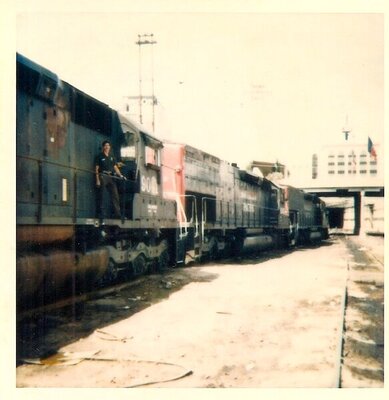Have you wondered what trains do without cabooses these days? At one time, they were a familiar sight on the end of each train, with a self contained crew who watched out for problems that the front end engineer didn't see. With radio communication, they'd let the driver know when they started moving, what the rear brake pressure was, when they were clear of a switch when pulling into a siding, plus they could apply emergency brakes from the rear. I was working on the caboose track, getting them ready for train trips and got the news around 1987 that they were on the way out. Now all you see on the back end of a train is a flashing red light.
View attachment 1065163
However, it's not just a light. This is an EOT, or End Of Train device, also known as an SBU (sense and braking unit) or FRED (flashing rear end device) and gives the locomotive engineer a lot of information.
View attachment 1065164As you can see, it attaches to the rear coupler on the tail end car with a screw on clamp - the fingers engage four holes cast into the coupler. You can also see that it is attached to the rear brake hose. This device has a motion sensor and will let the engineer know when there is movement at the rear of the train. See that number on the side (87172), each one has it's own unique number. When it is applied to the train, the person radios the head end and tells them the number which is then punched into a special radio control to communicate with this device. This make is impossible for one train to accidentally pick up a signal from a different unit on another train.
Besides the motion sensor, the radio signal also allows the engineer to initiate an emergency brake application from the tail. There could be a good reason to do this emergency braking, if there was a problem such as a kinked brake hose (it could happen when the cars bunch up together during deceleration) or water condensing in a hose and freezing to block airflow and preventing brake application from the front end. To make sure the signal is reading correctly, the pressure is also visible in a digital display on this unit, and if they don't match to front end reading within a couple of psi. then the unit must be replaced.
So there you have it, a piece of machinery that did away with the caboose. Originally, we had to keep a bunch of batteries on chargers and change them out every trip, but then they started installing tiny turbine generators in them so they'd develop their own power whenever the brake line was pumped up. They make a high pitched whine and are efficient, using very little air to power them.


 The Canadian cabooses also had at least......... the ones i remember had............a long telescoping pole and at one end there was a cable strung along its length to get near the ground level at high speed..
The Canadian cabooses also had at least......... the ones i remember had............a long telescoping pole and at one end there was a cable strung along its length to get near the ground level at high speed.. budget $$ reasons even tho they were FRA
budget $$ reasons even tho they were FRA  regulated here in the USA.
regulated here in the USA.














